

Favelas are more dangerous than the rest of the city, but they're also creative and cultural hubs © Tom Wilde / Getty Images
Most middle or upper class Brazilians will warn you off from visiting favelas. They're too dangerous, they'll tell you. It's too risky. Then the question will inevitably follow: why would you want to go to one anyway?
Slum tourism is a tricky subject. Visiting neighborhoods just to gape at residents is akin to visiting a human zoo. It shouldn't be done.
Visiting a community to better understand the lives of the people who live there, however, or to interact and exchange with them, to celebrate their unique culture and economically support local ventures or social projects – that's the sort of positive impact tourism is supposed to have on the world.
Maybe visiting a favela in Brazil isn't such a bad idea after all. Here are a few things you should know if you decide you go.
Understand the culture
Tourism can be an enriching exchange that valorizes the unique cultures that have grown out of socially marginalized zones, but the tendency to focus on the risks can easily diminish the importance of an area's contribution to society.
Case in point: favelas are more dangerous than the rest of the city, but they're also creative and cultural hubs of the country, producing the best sambistas, rappers and funkeiros, along with top artists, athletes and entrepreneurs.
According to Micael Amarante, who worked for the city of Rio as part of the UPP favela pacification project when it was first introduced, "easily the most relevant culture in Brazil today is favela culture." But that doesn't mean living in a favela is all rainbows and unicorns. Creativity is often born of necessity, and it's true that life in favelas can be quite difficult.
Ever wonder what it's like to live in a favela? Check out Carolina Maria de Jesus' celebrated autobiography, Quarto de Despejo - Diário de Uma Favelada, which gives a detailed account of day-to-day life in a favela in São Paulo. Although the book (which has been translated into 13 languages) is from the 1950s, Jesus' account of the realities of favela life is still very true today.
Local tip: A better understanding of both the positive and negative aspects of life in a favela will enrich your visit and help you to connect with local residents.


The best way to stay connected.
Saily provides a hassle-free solution to travel data — just choose your data plan and prepare for your trip. When you get to your destination, you can go online right away.
Get your eSIMKnow the rules
Even with the hardships, favela residents – like all Brazilians – are generally warm and welcoming. However, there are a few rules you should follow if you decide to visit.
Know where you can and can't go
Figure out which areas are safe. Some streets, for example, are to be avoided, as they're where human trafficking takes place. If you're told to stay away, do yourself a favor and stay away.
Always go with someone who knows
It's easy to get turned around in the labyrinth-like streets, so make sure you arrive with a guide, be it a local tour guide or a friend who works at a social project.
If you ever get lost or are unsure where to go, tell a resident who you are, who you're with and why you're in the neighborhood. Once the locals know your purpose, they'll help you get where you're going without a hassle.
Ask before you click
It's generally OK to take pictures in favelas, but avoid snapping shots that show someone's face unless you've asked for – and received – permission. In some favelas, the controlling gangs don't want any photos taken; in others, residents can be prosecuted by the police if even a minor discretion, such as smoking weed or underage drinking, is caught on film.
Now that we've got the rules down, here is a short list of ways to experience favela culture in Brazil.

1. Vidigal e Chácara do Céu
Sandwiched between the absurdly expensive neighborhoods of Leblon and São Conrado in Rio de Janeiro sits the well-known favela Vidigal and its little brother Chácara do Céu. Their brick and concrete block houses creep up the side of the iconic Dois Irmãos (Two Brothers) mountain, offering expansive views of Ipanema, Leblon, the Lagoa and the Cagarras Islands.
Its privileged location made Vidigal a magnet for tourism, with bars, party spots, restaurants and hostels popping up across the hillside. Foreigners, including David Beckham and Madonna, bought property, and a luxury hotel was even built on high (yes, we know, there are two sides to that argument).
Some of the top attractions are Alto Vidigal, a party space situated at the top of the hillside with breathtaking views; its neighbor Bar do Lage, a bar and restaurant with the same spectacular view; the Italian-South American restaurant Flor do Céu in Chácara do Céu (reservations only); the theater group Nós do Morro (We of the Hillside); Sitiê Parque Ecológico (Sitiê Ecological Park); and the trail to the top of Dois Irmãos mountain.
2. Morro da Mangueira
The favelas of the North Zone of Rio are certainly less visited and more risky than those of the South Zone. True lovers of samba, however, will need to add one to their itinerary: Morro da Mangueira, home of Rio's first samba school.
Samba schools are the organizations that put on Rio's famous Carnival parade, and the GRES Estação Primeira de Mangueira, as it is formally known, is one of the most famous samba schools in existence. Carnival and samba are the lifeblood of many Brazilians.
“[Visiting a samba school] isn't all clichés of Carnaval - it's an opportunity to experience our culture, which is a true work of art," Mangueira tourism guide Monica Bertazzolo said in an interview with Globo.
If you're in Brazil during Carnival season, you can also take tours of or see technical rehearsals at the Cidade de Samba (City of Samba), the complex where the samba schools prepare their parades.

3. Morro da Babilônia e Chapéu Mangueira
At the far end of Copacabana Beach, just behind the small residential neighborhood of Leme, sit the favelas Morro da Babilônia and Chapéu Mangueira, two relatively safe communities blessed with peaceful ocean views, Atlantic rainforest hiking and some of the best bar food in the city.
The tourist itinerary includes a stop at the 140m-long mosaic Mural Babilonia, a guided hike along the Circuito do Morro da Babilônia to Pedra do Urubu (Vulture Rock), a sunset drink at the ocean-view terrace of Estrelas da Babilonia (if you don't mind climbing the stairs to get there) and finally a stop at Bar do David, twice voted the second-best bar food in the city in the Comida di Buteco competition.
4. Paraisópolis
The second-largest favela in São Paulo, Paraisópolis has close to 100,000 residents – including Estevão Silva Conceição, known as the Brazilian Gaudi for his unique architectural stylings.
In 2019 Conceição's house was part of a project called Circuito Paraisópolis das Artes – an artistic tour of Paraisópolis that also included the Ballet Paraisópolis, Biblioteca BECEI (BECEI Library) and Casa de PET, a house constructed from green plastic PET bottles by Sr Antenor, another artist from the community.
Unfortunately, the COVID-19 pandemic put an end to the project, but tours highlighting the artistic prowess of Paraisópolis' residents are still organized by local guides and the community association.
Cultural immersion
Favela culture doesn't just exist in favelas. If you want to know more but feel uncomfortable with the risks, head to Lapa in Rio and check out a carioca funk show at the Fundição Progresso or visit a traditional Roda de Samba (like Pedra do Sal).
In São Paulo, stop by the newly inaugurated Museu de Favela for a deep dive into this epic street culture that's the heartbeat of Brazil.













